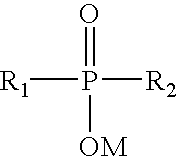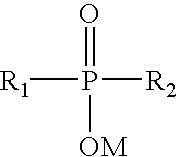Particulate inorganic solids treated with organophosphinic compounds
a technology of organophosphine and inorganic solids, which is applied in the field of particulate inorganic solids, can solve the problems that no known surface treatment is ideal for all applications, and achieve the effects of excellent dispersion, excellent dispersion, and easy dispersibility into polymers
- Summary
- Abstract
- Description
- Claims
- Application Information
AI Technical Summary
Benefits of technology
Problems solved by technology
Method used
Image
Examples
example 1
[0051]In this example, 0.90% of diisooctylphosphinic acid is added to dry chloride process rutile TiO2 base, which was coated with 0.20% alumina.
[0052]26.8 ml of a 386.4 grams Al2O3 / liter solution of sodium aluminate were added to 5,230 grams of fine particle chloride process TiO2 in a 350 grams / liter slurry with mixing at 70° C. The slurry pH was adjusted to 7.0 using a 50% sodium hydroxide solution, and the slurry was allowed to age for 30 minutes with stirring. The aged slurry was filtered and washed two times with 5000 ml aliquots of 80° C. deionized water, and then dried overnight at 115° C. in an oven. The dried filter cake was forced through an 8-mesh screen in preparation for treatment with diisooctylsulfonic acid.
[0053]9.0 grams of diisooctylphosphinic acid (Fluka Chemical) were added drop wise in a circular motion to 1000 grams of the dry, 8 meshed, alumina coated TiO2 prepared as described above, which was spread to a 1 cm thickness on polyethylene film. The pigment was m...
example 2
[0055]In this example, 1.10% of diisooctylphosphinic acid is added to dry chloride process rutile TiO2 base, which was coated with 0.20% alumina.
[0056]11.0 grams of diisooctylphosphinic acid (Fluka Chemical) were added drop wise in a circular motion to 1000 grams of the dry, 8 meshed, alumina coated TiO2 prepared as described in example 1, which was spread to a 1 cm thickness on polyethylene film. The pigment was mixed with a large spatula and transferred to a one gallon wide-mouthed Nalgene bottle. The bottle containing pigment was rolled for 10 minutes on a roller mill. The rolled pigment was steam micronized to produce the finished pigment.
[0057]The finished pigment was incorporated into 75% and 50% TiO2 containing low-density polyethylene masterbatch for dispersion and lacing evaluations, respectively. Results are given in Table 1.
example 3
[0058]Preparation of di-n-octylphosphinic acid. To a stirred mixture of 46.5 g (0.261 mol) of n-octylphosphinic acid in 250 mL 95% ethanol, 1-octene (58.6 g, 0.5218 mol) was added followed by 9.042 g (0.026 mol) of 70% benzoyl peroxide. The resulting mixture was refluxed for 8 hs, and then another 6.758 g (0.0196 mol) of benzoyl peroxide was added and the reaction continued to reflux for an extra 8 hs. A third 4.244 g of benzoyl peroxide was added (0.01305 mol) and refluxing continued for an extra 8 hs. The resulting mixture was cooled in the refrigerator, filtered, and 11.8 g of di-n-octylphosphinic acid was recovered using a rotary evaporator. The solid was washed with 100 mL of cooled 95% ethanol and the filtrate was concentrated on the rotary vacuum and replaced in the refrigerator. Another 24.9 g di-n-octylphosphinic acid was obtained on cooling to attain a total of 36.7 g (48.4% yield).
PUM
| Property | Measurement | Unit |
|---|---|---|
| particle size | aaaaa | aaaaa |
| particle size | aaaaa | aaaaa |
| particle size | aaaaa | aaaaa |
Abstract
Description
Claims
Application Information
 Login to View More
Login to View More - R&D
- Intellectual Property
- Life Sciences
- Materials
- Tech Scout
- Unparalleled Data Quality
- Higher Quality Content
- 60% Fewer Hallucinations
Browse by: Latest US Patents, China's latest patents, Technical Efficacy Thesaurus, Application Domain, Technology Topic, Popular Technical Reports.
© 2025 PatSnap. All rights reserved.Legal|Privacy policy|Modern Slavery Act Transparency Statement|Sitemap|About US| Contact US: help@patsnap.com



